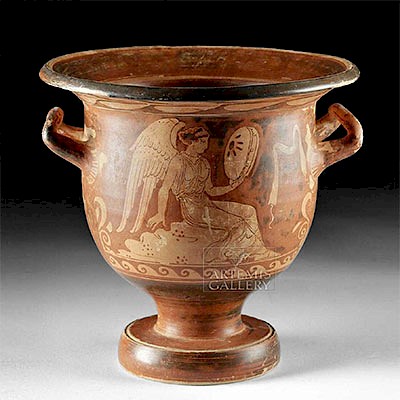Roman Parthian Glass Cup w/ Rigaree, ex-Royal Athena
Lot 63
About Seller
Artemis Fine Arts
686 S Taylor Ave, Ste 106
Louisville, CO 80027
United States
Selling antiquities, ancient and ethnographic art online since 1993, Artemis Gallery specializes in Classical Antiquities (Egyptian, Greek, Roman, Near Eastern), Asian, Pre-Columbian, African / Tribal / Oceanographic art. Our extensive inventory includes pottery, stone, metal, wood, glass and textil...Read more
Estimate:
$2,400 - $3,600
Absentee vs Live bid
Two ways to bid:
- Leave a max absentee bid and the platform will bid on your behalf up to your maximum bid during the live auction.
- Bid live during the auction and your bids will be submitted real-time to the auctioneer.
Bid Increments
| Price | Bid Increment |
|---|---|
| $0 | $25 |
| $300 | $50 |
| $1,000 | $100 |
| $2,000 | $250 |
| $5,000 | $500 |
| $10,000 | $1,000 |
| $20,000 | $2,500 |
| $50,000 | $5,000 |
| $100,000 | $10,000 |
| $200,000 | $20,000 |
About Auction
By Artemis Fine Arts
Mar 7, 2019
Set Reminder
2019-03-07 10:00:00
2019-03-07 10:00:00
America/New_York
Bidsquare
Bidsquare : VARIETY SALE | Antiquities & Ethnographic Art
https://www.bidsquare.com/auctions/artemis-gallery/variety-sale-antiquities-ethnographic-art-3928
Around the world & back in time - be amazed at the treasures you will find. Antiquities from Egypt, Greece, Italy and the Near East, Asian, Pre-Columbian, African / Tribal / Oceanic, Native American, Spanish Colonial, Russian Icons, Fine Art, much more! Artemis Fine Arts info@artemisfinearts.com
Around the world & back in time - be amazed at the treasures you will find. Antiquities from Egypt, Greece, Italy and the Near East, Asian, Pre-Columbian, African / Tribal / Oceanic, Native American, Spanish Colonial, Russian Icons, Fine Art, much more! Artemis Fine Arts info@artemisfinearts.com
- Lot Description
Roman, Parthian, Imperial Period, ca. 2nd to 4th century CE. A squat, free-blown, emerald-green glass cup with a concave base and a rough pontil scar, short walls, a shallow interior cavity, and a smooth, rolled rim. The exterior of the vessel displays three separate trails of applied rigaree, each beginning with a thick clump of glass and ending with a thin tail. Faint areas of silvery iridescence complement the vessel's verdant color and give it an elegant appearance. Given the overall form, this cup may have at one time been used as a taller beaker. The rim may have been re-fired after the top portion broke off so as to give it new life as a drinking vessel. Size: 2.45" W x 2.125" H (6.2 cm x 5.4 cm).
Ancient glass manufacture had begun in the 2nd millennium BC in Mesopotamia and Egypt. The Greeks and Phoenicians advanced glass technology greatly in the latter 1st millennium BC. In the early 1st century AD, Roman workshops began producing blown glass on a large scale. Eventually glass vessels came to replace a wide variety of pottery and metal wares in the ancient world. Ancient Roman glass was traded far beyond the Roman Empire. Roman glass vessels have been found in Scandinavia, India, and in Han Dynasty tombs in China.
For a similar example with an added foot, please see The Metropolitan Museum of Art, accession number 81.10.126: https://metmuseum.org/art/collection/search/245283
Provenance: private East Coast, USA collection; ex-Artemis Gallery; ex-private Metzger collection, Washington, D.C., USA; ex-Royal Athena Gallery, New York, New York, USA
All items legal to buy/sell under U.S. Statute covering cultural patrimony Code 2600, CHAPTER 14, and are guaranteed to be as described or your money back.
A Certificate of Authenticity will accompany all winning bids.
We ship worldwide and handle all shipping in-house for your convenience.
#133099Surface wear and light abrasions commensurate with age, light roughness to body and base, a few small chips along body, light fading to coloration, and some areas of russet-hued staining. Light earthen deposits within recessed areas and on edges of rigaree, and nice areas of faint silvery iridescence.Condition
- Shipping Info
-
All shipping is handled in-house for your convenience. Your invoice from Artemis Gallery will include shipping calculation instructions. If in doubt, please inquire BEFORE bidding for estimated shipping costs for individual items.
-
- Buyer's Premium



 EUR
EUR CAD
CAD AUD
AUD GBP
GBP MXN
MXN HKD
HKD CNY
CNY MYR
MYR SEK
SEK SGD
SGD CHF
CHF THB
THB

















